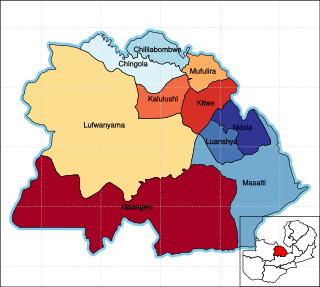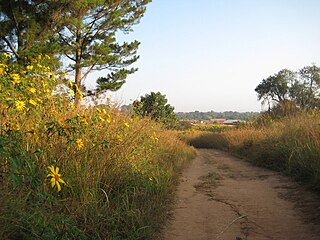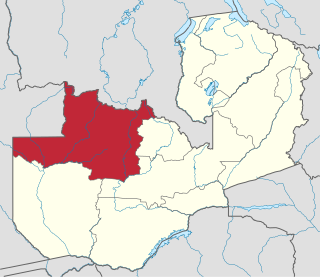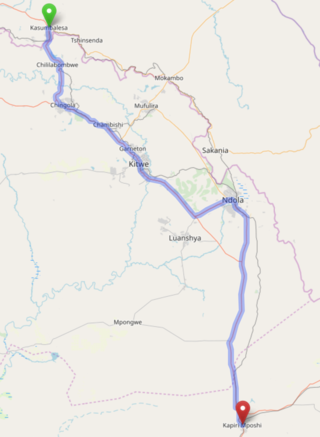This article is about the Transport in Zambia.
Solwezi is a town in Zambia. It is the provincial capital of the mineral-rich North-Western Province. Solwezi is also the administrative capital of Solwezi District, one of the eleven districts in the North-Western Province.

Chingola is a city in Zambia's Copperbelt Province, the country's copper-mining region, with a population of 216,626. It is the home of Nchanga Copper Mine, a deep-shaft high-grade content copper mining operation, which subsequently led to the development of two open pit operations, Chingola Open Pit and then Nchanga Open Pit.

The Kafue River is the longest river lying wholly within Zambia at about 1,576 kilometres (979 mi) long. Its water is used for irrigation and for hydroelectric power. It is the largest tributary of the Zambezi, and of Zambia's principal rivers, it is the most central and the most urban. More than 50% of Zambia's population live in the Kafue River Basin and of these around 65% are urban.

Copperbelt Province is a province in Zambia which covers the mineral-rich Copperbelt, and farming and bush areas to the south. It was the backbone of the Northern Rhodesian economy during British colonial rule and fuelled the hopes of the immediate post-independence period, but its economic importance was severely damaged by a crash in global copper prices in 1973. The province adjoins the Haut-Katanga province of the Democratic Republic of the Congo, which is similarly mineral-rich.
Hannington is a village in West Northamptonshire in England. At the time of the 2011 census the parish's population was 251 people.

Kitwe is the third largest city in terms of infrastructure development and second largest city in terms of size and population in Zambia. With a population of 517,543 Kitwe is one of the most developed commercial and industrial areas in the nation, alongside Ndola and Lusaka. It has a complex of mines on its north-western and western edges.

Mwinilunga is a town in the North-Western Province of Zambia. It is the headquarters of Mwinilunga District, one of the province's eleven districts.
Kabompo is a town in north-western Zambia, lying on the Kabompo River with a population over 88,000 people. It is surrounded by teak forest and is home to a Roman Catholic mission. Kabompo was founded in the 1900s or even earlier than that, the district centre was first situated in Nkulwashi before it was moved to its current location. The district boasts of its significance towards its contribution to the nation's food security through Food Reserve Agency (FRA). Even in the late 60's and early 70's Kabompo was very active in agricultural activities through NAMBOARD.
Moshupa is a large village in the Southern District of Botswana with a population of 20,016 per the 2011 census. The people of Moshupa are called the Bakgatla-ba-ga Mmanaana, a group also found in Thamaga. Along with the related Bakgatla-ba-ga Kgafela of Mochudi, they arrived to the region from the Transvaal region in South Africa throughout the eighteenth century.

North-Western Province is one of ten Provinces of Zambia. It covers an area of 125,826 km2 (48,582 sq mi), has a population of 727,044 and a population density of 5.80 per square kilometre as of 2010. It is the most sparsely populated province in the country. The provincial capital is Solwezi. The literacy rate stood at 63 per cent against a national average of 70.2 per cent. The rural population constituted 77.45%, while the urban population was 22.55%. North-Western Province is bordered along Angola in the west, the Democratic Republic of Congo in the north, Copperbelt Province in the east, Central in the south-east, and Western Province in the south-west.

Sungai Pelek is a town in Sepang District, Selangor, Malaysia. The town is located about 20 minutes from the Sepang International Circuit and about 25 minutes from the Kuala Lumpur International Airport. The town is near Bagan Lalang beach. It has numerous mangrove forests and the local clay supports a thriving brick-making industry.
The Constitution of Laos provides for freedom of religion; however, the Government restricted this right in practice. Some government officials committed abuses of citizens' religious freedom.

Water supply and sanitation in Zambia is characterized by achievements and challenges. Among the achievements are the creation of regional commercial utilities for urban areas to replace fragmented service provision by local governments; the establishment of a regulatory agency that has substantially improved the availability of information on service provision in urban areas; the establishment of a devolution trust fund to focus donor support on poor peri-urban areas; and an increase in the access to water supply in rural areas.
Mutanda is a town in Kalumbila District, North-Western Province, Zambia. It is approximately 33 kilometres (21 mi), by road, southwest of Solwezi. Mutanda is situated approximately 500 kilometres (310 mi), by road, northwest of Lusaka, the capital.
'Lumwana is a mining town located in Mwinilunga District, within the North-Western Province of Zambia.
Chambishi is a town in Kalulushi District in the Copperbelt Province of Zambia. According to the 2021 Census its population stands at slightly above 11,000. It is located on the T3 Road between the cities of Kitwe and Chingola.

The T3 is a Trunk Road in Zambia. The road runs from Kapiri Mposhi via Ndola, Kitwe and Chingola to Kasumbalesa on the border with DR Congo. The entire route is a toll road.

William Harrison "Harry" Anderson was an American missionary for the Seventh-day Adventist Church. He arrived in Africa in 1895 and established the Solusi Mission near Bulawayo, Rhodesia. Anderson and the mission survived the Second Matabele War and a 1899–1901 malaria outbreak. In 1903 he established the Rusangu Mission in the north of Rhodesia, which now hosts schools and a university. Anderson later worked in the Bechuanaland Protectorate and Angola. From 1935 to his retirement in 1945 he was employed by the Seventh-day Adventist Church's Africa Division with responsibilities stretching from Cape Town to Lake Chad.

Nchanga Copper mine, previously the Chingola Copper mine, is an underground and open-pit cobalt and copper mine in Chingola, in the Copperbelt Province of Zambia. It is the largest copper mine in Africa. It is owned by the Konkola Copper Mines, a joint venture between Vedanta Resources and the state mining company of Zambia.









